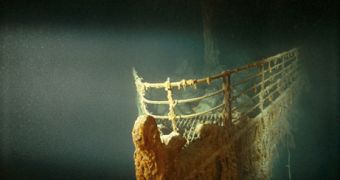Well, its no secret that the investigation that led to the discovery of the wreck of RMS Titanic was a secret US Navy operation destined to gather information about two of its downed nuclear submarines. However this is the first time when the Navy agrees to disclose complete details regarding the circumstances of the discovery of the famous ocean liner.
"The Navy is finally discussing it", said Robert Ballard, an oceanographer from the University of Rhode Island and the Mystic Aquarium and Institute for Exploration, the man who discovered the wreck in 1985. According to Ballard, in 1982 he went to meet with the Navy and ask for the funding necessary to build a robotic submersible capable of finding the Titanic.
The US Navy representative in the discussion with Ballard, Ronald Thunman, told him that the Navy would gladly fund the operation, but for other purposes, like finding two of its nuclear submarines resting on the bottom of the ocean. Ballards agreed and then asked for the express permission to look for the Titanic at the end of the mission. Thunman didn't mention the Titanic, but he said that after the wrecked subs were found Ballard could do whatever he wanted.
Ballard says that even the Navy Secretary knew of his plan to search the Titanic, "but the Navy never expected me to find the Titanic, and so when that happened, they got really nervous because of the publicity."
The two sunken nuclear submarines were the U.S.S. Thresher and the U.S.S. Scorpion, located at depths of 3,000 respectively 4,600 meters while the Titanic was located somewhere between the two. The Navy wanted to know what risk the nuclear reactors of the wrecks posed for the oceanic environment, if disposing of additional nuclear material was safe and what had downed the Scorpion.
The investigation revealed that the nuclear reactors of the two were not affecting the oceanic environment in any way and that the Thresher most likely sank due to a piping failure while the Scorpion's sinking circumstances were less obvious. Nevertheless, evidence suggested that the forward compartments were flooded during an unfortunate accident, but the other compartments remained intact until they imploded under the tremendous pressure.
"We saw no indication of some sort of external weapon that caused the ship to go down", Thunman said.
The experience not only gave Ballard the opportunity to look for Titanic, but also to learn how debris of a sinking ship behaved under the influence of oceanic currents, which made him speculate that Titanic must have broken in half before sinking leaving a trail of debris on the ocean floor as it did.
"That's what saved our butts. It turned out to be true", Ballard added.
Ballard still uses the technique today in his expeditions in search of sunken ships, but he says that he no longer has anything to do with top-secret military investigations. "The Cold War is over. I'm no longer in the Navy", he said.

 14 DAY TRIAL //
14 DAY TRIAL //